Wales |
|
|
|
| Übersicht – Contents: | |
Diese Seite ist Teil des Projektes
Wales |
|
|
|
| Übersicht – Contents: | |
Flaggen – Flags: |
|
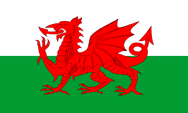 |
seit/since 1959, Flagge von Wales – flag of Wales, Seitenverhältnis – ratio = 3:5, Quelle/Source, nach/by: Corel Draw 4 |
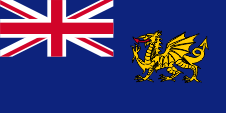 |
seit/since 2017, Flagge für Regierungsschiffe – flag for governmental vessels, Seitenverhältnis – ratio = 1:2, Quelle/Source, nach/by: Wikipedia (EN) |
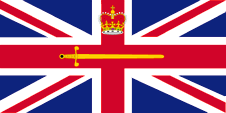 |
Flagge des Lord High Commissioner von Wales – flag of the Lord High Commissioner of Wales, Seitenverhältnis – ratio = 1:2, Quelle/Source, nach/by: Flags of all Nations |
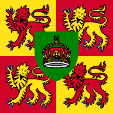 |
Flagge des Prinzen von Wales – flag of the Prince of Wales, Seitenverhältnis – ratio = 1:1, Quelle/Source, nach/by: Flags of all Nations |
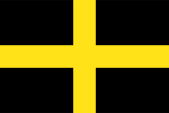 |
Flagge von St. David – flag of Saint David, (inoffizielle Nationalflagge – unofficial national flag) Seitenverhältnis – ratio = 2:3, Quelle/Source, nach/by: Wikipedia (EN) |
historische Flaggen – historical Flags: |
|
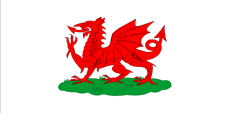 |
1907–1953, Flagge von Wales – flag of Wales, Seitenverhältnis – ratio = 1:2, Quelle/Source, nach/by: World Statesmen |
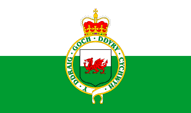 |
1953–1959, Flagge von Wales – flag of Wales, Seitenverhältnis – ratio = 3:5, Quelle/Source, nach/by: World Statesmen |
| Wales verwendet keine eigene Heraldik (mehr). Alle heute verwendeten Farben und Symbole sind englischen Ursprungs. Die eigentlichen Wappenfarben von Wales sind Gelb und Rot, wie die Englands. Um 1500 wurde der walisische rote Drache, der als Zeichen schon sehr alt ist, mit den grün-weißen Tudorfarben zur heutigen Flagge kombiniert. | Wales no
longer uses its own heraldic symbols. All of today’s colours and symbols are
of English origin. The actual colours of Wales’ coat of arms are yellow and
red, as the English. In about 1500 the Welsh dragon, a very old symbol, was
combined with the green-white Tudor colours to make up today’s flag. |
| Wales ist keltisches Gebiet, und die Kelten verwenden eigentlich Flaggen und Wappen in ihren Nationalfarben Schwarz und Weiß. Dies hat sich jedoch nur in der Bretagne und in Cornwall bzw. mit Einschränkungen in Schottland erhalten, bzw. ist dort zum tragen gekommen. Alle anderen keltischen Gebiete haben ihre Heraldik von ihren jeweiligen Herrschern entlehnt oder aus anderen Kulturkreisen importiert. Die britischen Nordinseln (Nordische Inseln) verwenden skandinavische Modelle, Irland ist von der französischen Trikolore beeinflusst, Wales und Man haben englische Heraldik übernommen. Durch den Lauf der Geschichte war Wales zum Zeitpunkt der Bildung des Vereinigten Königreiches, der Union, Vollbestandteil (quasi unterworfenes Gebiet) Englands, und hatte so nie eine Chance seine – wenn auch fremde Heraldik – irgendwo einfließen zu lassen, weder in die englische Flagge, noch in die des Vereinigten Königreichs. Das Wales heute als "gleichberechtigter" Bestandteil des Vereinigten Königreichs erscheint, ist nur dem im 19./20. Jhd. aufkommenden walisischen Nationalismus zu verdanken, so dass es seit 1912 beschränkte Autonomie genießt, und seit 1999 sein eigenes Regionalparlament besitzt. | Wales is
Celtic territory and the Celts actually use flags and coats of arms in their
national colors of black and white. This is preserved, however, only in the
Bretagne (Brittany) and in Cornwall, with limited usage Scotland. All other
Celtic territories have borrowed their heraldry from their respective
sovereigns or imported them from other cultural circles. The British
Northern Islands (Nordic Islands) use Scandinavian models, Ireland is
influenced by the French Tricolor, Wales and the Isle of Man have taken
English heraldry. In the course of time Wales was at the time of the
establishment of the United Kingdom a full constituent member of England (a
subjected region), and, due to this, had never an opportunity to contribute
– albeit her foreign heraldry – anywhere to the English flag or to the flag
of the United Kingdom. That Wales appears today as "having equal rights" in
the United Kingdom, is only owed to the rise Welsh Nationalism in the 19th
and 20th centuries so that it enjoys limited autonomy since 1912 and has its
own regional parliament since 1999. |
| Erst in den letzten Jahren hat sich eine Flagge als Symbol des walisischen Nationalbewusstseins etabliert. Es handelt sich um die Flagge des Heiligen David. Das Bild der Flage wurde vom Wappen der Diözese St. David entnommen, goldenes Kreuz auf Schwarz. Sie wird von Nationalisten werwendet, oder auch von Christlichen Partei. Die Gründe der Ablehnung der offiziellen walisischen Flagge sind entweder die Ablehnung englischer Heraldik oder gar die Ablehung des Drachens als Symbol Satans. | Only in recent years has a flag established itself as a symbol of Welsh national identity. It is the Flag of Saint David. The image of the flag was taken from the Coat of Arms of the Diocese of St. David, golden cross on black. It is used by nationalists, but also by the Christian Party. The reasons for rejecting the official Welsh flag are either the rejection of English heraldry or even the rejection of the dragon as a symbol of Satan. |
| Quelle/Source: Die Welt der Flaggen, 1) Wikipedia (EN), 2) Wikipedia (EN), Volker Preuß | |
| Wappen – Coat of arms: | |
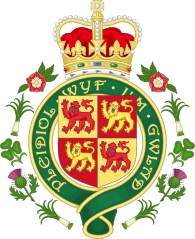 |
Wappen von Wales – coat of arms of Wales, Quelle/Source: Sodacan, CC BY-SA 3.0, via Wikimedia Commons |
| Das Wappen von Wales zeigt einen gelb-rot gevierteilten Schild mit je einem blaubewehrten Leoparden in umgekehrter Färbung in jedem Feld. Es geht auf das Banner von Owain Glyndŵr (Fürst von Wales im 14. Jahrhundert) zurück. Der Wahlspruch "Pleidiol Wyf I’m Gwlad" heißt übersetzt: "Treu bin ich meinem Land" und entstammt der walisischen Nationalhymne. | The coat of arms of Wales shows a yellow and red quartered shield with a blue-armoured leopard in reverse color in each field. It goes back to the banner of Owain Glyndŵr (14th century Prince of Wales). The motto "Pleidiol Wyf I'm Gwlad" means "I am loyal to my country" and comes from the Welsh national anthem. |
| Quelle/Source: Wikipedia (DE) | |
Landkarte – Map: |
Lage – Location: Quelle/Source: Freeware, University of Texas Libraries, modyfied by: Volker Preuß |
Landkarte des Landes – Map of the Country: |
|
|
Zahlen und Fakten – Numbers and Facts: |
|
|
|
|
|
|
|
|
|
|
|
|
|
|
|
|
|
ca. 600 v.Chr. · keltische Besiedlung 57 v.Chr.–74 n.Chr. · zum Römischen Reich, Provinz Britannia ab ca. 400 · Abzug der römischen Legionen, in den Folgejahren Einwanderung der germanischen Stämme der Angeln, Sachsen und Jüten nach Britannien, die später unter dem Begriff Angelsachsen zusammengefasst wurden, Wales wird Rückzugsgebiet für die keltischen Briten 1066 · die einfallenden Normannen besiegen die Angelsachsen in der Schlacht von Hastings und Errichten ihre Herrschaft in England und auch in Wales 1301 · Eduard I. unterwirft Wales endgültig 1416 · letzte nationale Erhebung der Waliser gegen das englische Joch 1536 · Wales wird mit England vereinigt 1912 · Gewährung begrenzter Eigenständigkeit 1999 · ein walisisches Regionalparlament nimmt seine Arbeit auf |
|
ca. 600 B.C. · Celtic settlement 57 B.C.–74 A.D. · to the Roman Empire, province of Britannia from ca. 400 · withdrawal of the Roman legions, in the following years immigration of the Germanic tribes of the Angles, Saxons and Jutes to Britannia, which were later summarized under the term Anglo-Saxons, Wales becomes a retreat for the celtic British 1066 · the invading Normans defeat the Saxons at the battle of Hastings and establish their power in England and even in Wales 1301 · Edward I. subjects Wales ultimately 1416 · last national uprising of the Welshmen against the English yoke 1536 · Wales is united with England 1912 · concession of limited autonomy 1999 · a Welsh regional parliament begins its work |
| Quelle/Source: Atlas zur Geschichte, Discovery '97, Wikipedia (D) |
| Der Name des Landes geht auf das germanische Wort "welsch" zurück, womit zunächst die Kelten im Allgemeinen gemeint waren, später auch Romanen. Die übertragene Bedeutung des Wortes "welsch" als "fremd" hat sich bis in die heutige Zeit erhalten. Auf Walisisch heißt das Land "Cymru", was auf das keltische Wort "Kom-brogi" zurückgeht und "Landsleute" heißt. | The name of the country goes back to the Germanic word "welsch", which initially meant the Celts in general, and later also the Romans. The figurative meaning of the word "welsch" as "foreign" has been preserved to this day. In Welsh, the country is called "Cymru," which derives from the Celtic word "Kom-brogi", meaning "countrymen". |
| Quelle/Source: Wikipedia (DE) | |